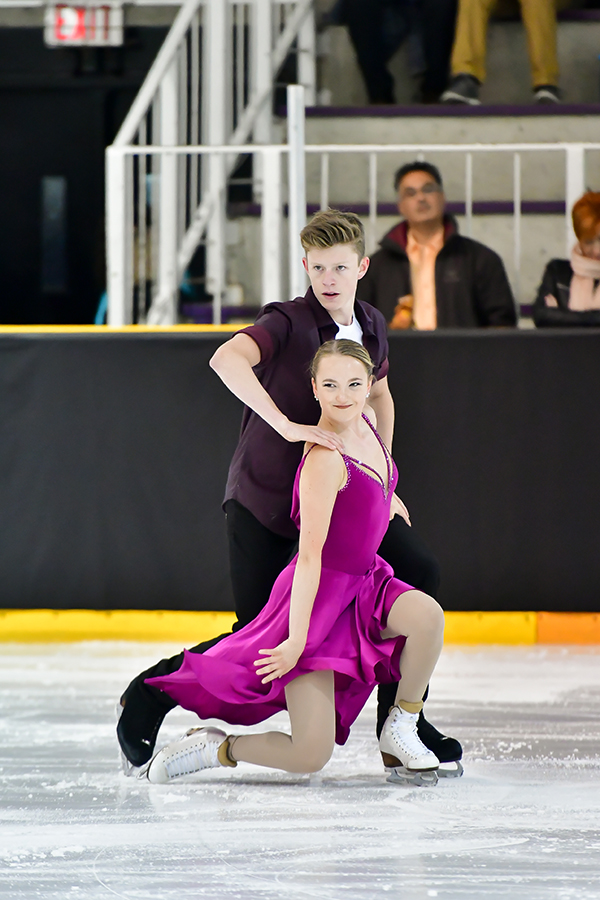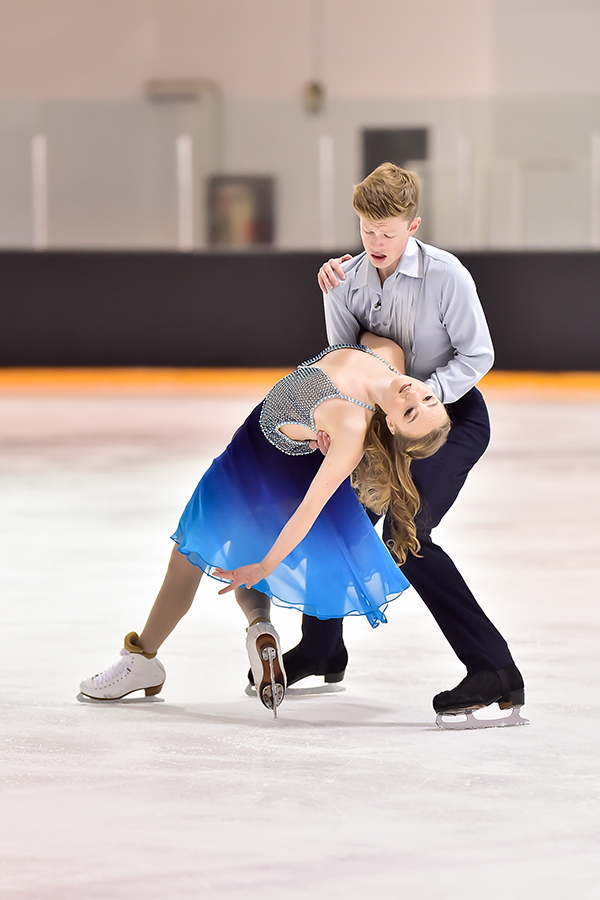by Jacquelyn Thayer
It’s common enough for skaters with neighboring levels of success — she a 2014 national novice champion with her previous partner, he 2015’s novice bronze medalist with his — to forge new partnerships as prior ones conclude. For Canadian juniors Keelee Gingrich and Parker Brown, such a match has also meant another leap — for former pair skater Gingrich into Brown’s discipline of ice dance.
Gingrich and Davin Portz finished seventh in the junior pairs event at 2016’s Canadian Championships, while Brown placed sixth with Ellie Fisher in dance. Both partnerships concluded after the season, leaving all four skaters in the hunt. Gingrich and Brown tackled their first tryout together in March, while she also continued to weigh options in pairs. A friendly relationship between personnel at Brown’s Mariposa School of Skating and Gingrich’s Calalta Figure Skating Club helped foster a stronger connection.
“After a few flights for Keelee back and forth from Ontario to Alberta, we decided that we were going to commit to each other and train at the Mariposa School of Skating,” said Brown.
For Gingrich, the switch across disciplines prompted a few revelations. “I noticed that the focus was directed less towards the technical elements and more towards each individual step involving both transitions and elements,” she said. “I have also noticed that musicality and timing plays a much more crucial role in ice dance than pairs.”
A sense of music was also central to the team’s immediate program plans.
After more traditional, and sometimes youthful, programs in their prior pairings, a blues-rock short dance to Canadian artist Colin James’ “Why’d You Lie” sets a rather novel tone. Brown, born more than a decade after the song’s release, had long wished to skate to the piece, but with coaches David Islam and Kelly Johnson, the skater agreed that its maturity level exceeded his own. But for the set of now 17-year-olds – Gingrich turns 18 in October – the number, paired with the rockabilly swing of Rick Krive’s “Jump Swing Blues,” seemed a good fit for a new, more adult focus in skating and performance.
“I think as a new junior team we really wanted to come across as very mature and be able to compete with the top Canadian teams,” said Brown. “[“Why’d You Lie”] is a very sensual piece that Keelee and I figured we would be able to pull off quite well due to the maturity we have in our skating.”
The free dance takes a softer tack. Late in the tryout process, Johnson and the team experimented with a few different musical styles and selections, eventually crafting a bit of choreography to a cut from Amelie. With that, “we knew lyrical was the way to go for us,” said Gingrich, though a final music decision remained.
After a flirtation with “Moonlight Sonata,” Brown’s sister, a classical pianist, directed the team towards the contemporary work of Ludovico Einaudi. The final product was choreographed by Detroit’s Pasquale Camerlengo, an “extremely fun yet interesting” process, said Gingrich.
“Obviously I was very new to dance choreography at that point so I wasn’t sure what to expect,” she said. “Our short dance was choreographed by Kelly Johnson who I had worked previously with in pairs, so I was much less nervous for that. Pasquale is an amazing choreographer and we both loved working with him and we are so happy with the final product that he gave to us.”
With Portz, Gingrich competed on 2014-15’s Junior Grand Prix circuit, while Brown with Fisher was entered as an alternate for the 2015-16 series; given strong performances and scores this summer, the new team would likely have earned consideration for an assignment to this year’s JGP circuit. Bronze at August’s Central Ontario Summer Skate, though, was offset by other flawed outings – including three falls in their debut short dance at July’s Minto Summer Skate – which diminished those international possibilities.
“That was obviously disappointing to us, but I feel we’ve realized that looking at the big picture is much more important and beneficial to us,” said Brown.
Gingrich, for her part, also remains focused on personal improvement. “One of my goals is to continue to develop my skating skills and transform into an ice dancer as this is my first season in this discipline,” she said.
And Brown thinks a less-than-ideal skate like Minto’s has helped him learn how to draw a positive from a negative. “After that performance it was extremely mentally exhausting to forget about that and focus on the free dance only fifteen hours later,” he said. “I am extremely proud of us for dealing with that situation in a positive manner and coming out the next day to skate an overall decent free dance.”
The process of growing together as a team in times of such challenge has proven a prime educational experience. “We both have different strengths and weaknesses and it’s about learning how to use each other to improve together as a team,” said Gingrich. “Personally, I struggled with achieving consistent twizzles and turn quality. However, Parker’s knowledge and patience has really benefited me and helped my growth as an ice dancer.”
But Brown also noted one technical quality that came more easily. “I feel we have very natural way of generating speed on the ice,” he said.
Off-ice training reinforces a dance-oriented focus, with three sessions a week zeroing in on ballet and lyrical with instructor Lindsey Arnold and ballroom with Linda Marsella. Strength and agility work with trainer Dave Blaise rounds out their schedule, along with yoga, a summer course which Gingrich intends to continue into the season.
And together they’re drawing technical inspiration from a few other Canadian teams of recent vintage — who have also faced a spectrum of adversities and successes. Olympic, World and six-time national champions Tessa Virtue and Scott Moir are a natural pick for Brown. “The intricacy of everything they do amazes me and I’m excited to see their debut this season at Autumn Classic after a couple years off,” he said.
Mariposa’s most prominent dance alumni, three-time senior national medalists Alexandra Paul and Mitch Islam, also loom large. “I love how they are able to generate so much speed while staying in a closed hold and making it look effortless,” said Brown. “We get the privilege to skate with Alex and Mitch a few times a year when they’re home in Barrie which is very enjoyable and inspiring.”
“I really enjoy the occasional time we get to share the ice with them and skate next to a top senior team from Canada,” agreed Gingrich, who appreciates the couple’s look and flow. Gingrich also admires a recently-departed pair who achieved highly in the junior ranks – Madeline Edwards and ZhaoKai Pang.
“I remember watching them when I was really young and they were juvenile or maybe pre-novice,” she said. “I have loved their connection and expression.”
Outside skating, both partners are currently occupied with coursework at Barrie’s Innisdale Secondary School. Gingrich, who formally graduated from high school in spring, is taking additional classes, while Brown completes Grade 12 with plans for future university study in commerce.
Each enjoys socializing with friends, with Facetime providing a useful link for Gingrich with friends and family in Calgary. And Brown makes time for another passion in music, playing the drums as well as additional instruments.
The couple is set to compete next month at the Skate Ontario Super Series Finale, held at their home base in Barrie, offering some additional mileage before December’s Skate Canada Challenge and January’s national championships. And Brown believes the stage could be set for a shake-up in the ranks.
“Another goal that Keelee and I set at the beginning of the season is to be on the podium at Canadians,” he said. “As of right now, we still strongly believe that if we train the way we know we’re capable of for the months to come, it is fully possible for us to receive a medal at Canadians.”
QUICK TAKES:
With some collaboration with Kelly Johnson, both partners took initiative in devising this season’s costume concepts, with the final products largely created by Niagara on the Lake’s Denis Pizzacalla. Brown’s goal was “simple and casual” for the short dance, more formal for the free; Gingrich aimed for sophistication in her pieces, making note of the color and mature cut of the short dance’s dress.
And certain of Pizzacalla’s past work for Tessa Virtue proved quite key.
“For the free dance I actually got my idea from Tessa Virtue’s free dance dress from the 2010 Vancouver Olympics,” said Gingrich. “The dye and colors of the skirt was an idea from Kelly which she saw from watching videos of the show So You Think You Can Dance. I fell in love with the dye job on the skirt and I’m beyond impressed by the work.”
♦
Brown noted the ways in which his musical inclinations have underpinned his approach to skating, from overt expression to more subtle gesture.
“Our free dance music took eight different takes to get it just the way I wanted,” he said. “Thankfully Keelee was very open about the cuts in that program, but there are so many little nuances in the music that are placed just the way I asked. Music is what pulls me through a program — if I forget about everything else and just listen to the music and fully commit to my character with Keelee, that is when I perform at my best. I think a lot of people take music for granted on and off the ice and I’m really glad I’m able to appreciate it.”
And maybe, Brown suggested, it could manifest itself in another form.
“It involves a lot of air drumming,” he quipped.


